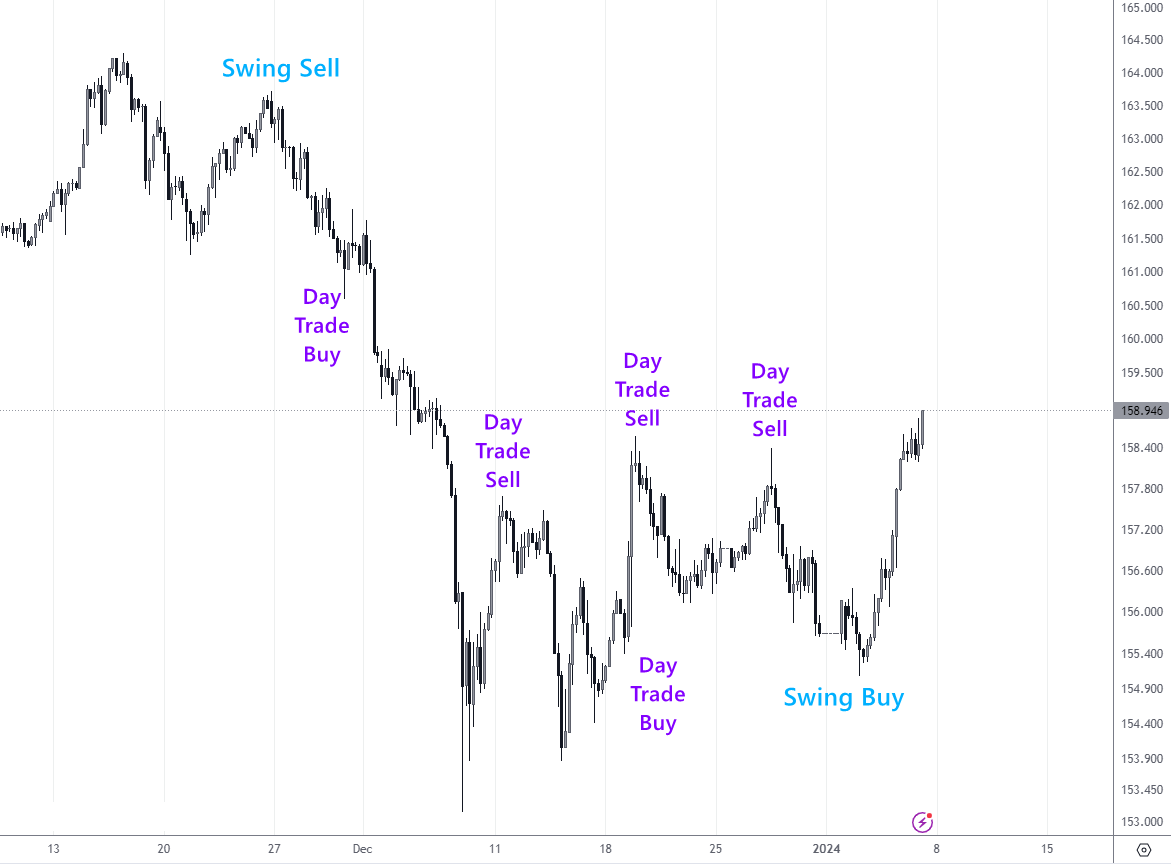The Trading Style Guide: Day Trading vs Swing Trading
TU explains day trading, swing trading, and the difference between the two:
-
Day trading is fast-paced, has the potential to generate quick profits in a short time, and avoids overnight fees. However, it requires experience and a lot of capital
-
Swing trading involves less risk and is less stressful without the need for as much expertise. However, profit generation is slower, and it comes with overnight risk.
There are many ways to approach trading out there, but two of the most well-known are day trading and swing trading.
-
Day trading involves entering and exiting trades within the same day, trying to capture small price movements by frequently trading.
-
Swing trading, however, is about entering trades for longer periods and trying to enter and exit a “swing” at the optimal time, to capture larger chunks of profit.

Day Trading vs Swing Trading
In this article, Traders Union explains what day trading is and what swing trading is and compares the two in an attempt to decide which is the cream of the crop.
-
Is swing trading better than day trading?
It's not about one being universally better. Day trading suits those wanting quick, intraday moves, while swing trading offers a more relaxed pace, with traders usually holding positions for days, weeks, or months. Your preference depends on your individual goals, time commitment, and risk tolerance.
-
Do swing traders make more money?
Successful swing traders can make substantial profits, but it varies based on market conditions, strategies, and individual skills. Typically, swing traders can make larger profits as they are trading on wider price movements than day traders, but they engage in fewer trades. Profits tend to be less frequent and consistent for swing traders.
-
Is swing trading better for beginners?
Beginners hoping to begin making a profit quickly may be tempted to day trade, as swing trading requires patience and more long-term goals. However, swing trading is more advisable for beginners as it involves less risk. Intraday trading requires a deeper understanding of markets and is best done after gaining some trading experience.
-
Can you swing trade daily?
No, swing trading typically involves holding positions for a few days to weeks. While you can be active on a daily basis, true swing trading doesn't require daily trades. Swing trading focuses on capturing price swings within the broader market trend – day trading is about profiting from daily movements.
-
Is Swing Trading Safer Than Day Trading?
A case could be made that day trading is safer, as intraday movements tend to be significantly smaller than swing trading price changes over multiple days or weeks. However, if the risk is controlled, then both should be as safe as the other. For example, a trader could limit losses to 2% on each trade, whether day trading or swing trading.
Understanding day trading
Day trading is perhaps the most well-known form of trading. Before the age of the internet, traders would flock to stock markets and currency exchanges to engage in trading or conduct them over the phone. With online technology, the fast-paced world of day trading is available to anyone.
Day trading definition
Day trading, sometimes called “intraday trading”, is defined as the rapid buying and selling of financial assets for profit within the same day – hence the name day trading. When you engage in day trading, the aim is to capitalize on small price movements, leveraging volatility in the market. Technical analysis is often incorporated into a day trading strategy, with charts and indicators facilitating quick decision-making. Day traders don’t hold positions overnight and instead seek to profit from intraday price fluctuations during a single market session.
Traders are drawn to day trading due to its potential to generate quick gains, despite the increased level of risk involved. Day trading requires strong market knowledge, as day traders must make quick decisions based on an understanding of markets. When day trading, you usually need to stay up-to-date with market news, economic reports, and other fundamentals that could influence the price of your traded asset. More importantly, however, you need to have a confident grasp of how to use technical analysis tools such as a professional trading platform, charting software, and various technical indicators.
Day traders might use various strategies, such as:
-
Scalping: This involves making a lot of small trades to exploit minimal price movements of 1-2%. Traders aim for small profits per trade but execute a high volume of trades.
-
Trend following: Traders identify and follow prevailing market trends, entering positions in the direction of the trend. This strategy relies on momentum by attempting to enter the trade early in the trend and selling before it reverses.
-
Breakout trading: With this strategy, traders enter positions when an asset's price appears to break through a significant level of support or resistance, anticipating a sustained price movement.
-
News trading: Involves reacting to market-moving news events. Traders quickly enter and exit positions based on the impact of news on asset prices. They are likely to follow economic calendars and time their trades to profit from short-term market reactions.
-
Leverage: Day traders often use leverage, which essentially means trading with borrowed money using margin (collateral). This allows them to increase profits by several orders of magnitude, but also magnifies risk. Day traders can avoid the overnight fees associated with using leverage.
Advantages and disadvantages of day trading
Day trading has several advantages which make it an appealing tactic for many, though it is of course not without its drawbacks.
👍 Pros
• Quick profit potential: As day traders are executing multiple trades a day, there is an increased level of opportunity to make quick gains – so long as everything goes according to plan. Profit generation from successful day trading can be much quicker than with more long-term forms of trading.
• No overnight risk: As day traders close all their positions before the day’s end, there is no risk of being exposed to further risks overnight. Any market news that affects an asset price outside of market hours does not affect day traders.
• Excitement: For many traders, day trading provides an adrenaline rush that would not be found in slower long-term trading. The active trading of assets with rapidly fluctuating prices adds a level of fast-paced excitement that would be absent when swing trading.
👎 Cons
• Steep learning curve: Day trading requires a particular set of skills that can be difficult to master. Day traders need to understand technical analysis in depth, while also understanding the fundamentals of the markets they’re trading. This can take years to develop.
• Expenses: Due to the sheer volume of trades that day traders make, they are likely to incur more transaction costs than usual. Obtaining live price quotes and paying commissions on multiple trades can also add up.
• Full-time: Day trading often means spending all market hours closely paying attention to market movements, which can be incredibly time-consuming. While this might be suitable for some, it’s not feasible for those with full-time jobs.
Traders Union explains in more detail the advantages and disadvantages of day trading in this article: Is Day Trading a Good Idea? Top pros and cons.
Best Forex brokers


Understanding swing trading
Swing trading is the less fast-paced, lower-risk counterpart to day trading. Rather than trying to capture profits from price movements within a single day, swing traders play the long-game, attempting to profit from price movements over longer periods.
Swing trading definition
Swing trading is a trading style in which traders attempt to profit from the short to medium-term price movements of a financial asset. It gets its name from the swings in price (up then back down) that a trader will try to anticipate and trade. Swing traders will typically hold a position for several days or weeks, as opposed to less than a day, as day traders do. Although swing traders may still use their trading platform daily for assessing positions or altering them, they usually don’t actively trade each day.
Swing traders try to capture a chunk of profit from potential future price movements. They identify where each asset’s price will likely move next, invest at the onset of a directional trend, and then exit when they believe the momentum or trend to be over. They will not hold positions long-term but instead move on to the next trade.
Swing traders typically use a combination of technical analysis to identify patterns and entry and exit points, and fundamental analysis to better understand the general behavior of the assets they trade.
Benefits and drawbacks of swing trading
Swing trading comes with several advantages and disadvantages.
👍 Pros
• Not time-consuming: Swing traders usually only need to trade for a few minutes or less than an hour each day or less frequently. Though they spend some time entering or exiting new trades, they are not required to do so daily. This makes it suitable for part-time traders.
• Less stress: Swing trading involves lowered levels of stress as it doesn’t require you to make split-second decisions or constantly monitor trading charts.
• Flexibility: Swing traders don't need to monitor the markets constantly. Positions are held for days or weeks, allowing for a more relaxed trading approach.
👎 Cons
• Overnight risk: Since swing traders leave their trades open for more than a day, prices could fluctuate or significantly change overnight or outside of their active hours, leading to enhanced risk.
• Missed opportunities: Swing traders open short to medium-term trades, so miss out on the intraday opportunities where prices move in counter trend directions, which day traders and scalpers capitalize on.
• Less active trading: For those who enjoy the excitement of frequent trades, swing trading might seem slow-paced and less engaging.
Swing trading can take many forms, so we examined the top six swing trading strategies. Read about it here: Top 6 Forex Swing Trading Strategies to Learn.
Swing trader or day trader? What’s the difference?
Although day trading and swing trading are probably the most popular and well-known styles of trading, with some similarities, they also have several differences. While day trading is fast-paced, and aims for small but rapid gains, swing trading opts for larger profit targets at a slower pace. Let’s look at the differences in more detail.
1. Holding period
In day trading, traders exit positions before the market closes, on the same day that they entered the position, with a trade lasting minutes or hours. It's like riding small, frequent waves. With swing trading, positions are held anywhere from a few days to several weeks, with the aim of catching larger but less frequent market swings. Imagine it as surfing bigger but slower waves.
2. Time commitment
Day traders are required to constantly monitor their trades and make quick decisions. This is more akin to a full-time job, with traders often quitting their 9-5 to take up intraday trading. Swing trading, on the other hand, demands much less daily attention. Swing traders can access their trading account for as little as a few minutes a day, and either update their held positions or just check price levels. It doesn’t require constant observation.
3. Trading frequency
Day traders engage in a high volume of trades each day to capitalize on intraday price fluctuations. Since the profits from day trading tend to be comparatively small, day traders need to execute a lot of trades. Conversely, swing trading focuses on fewer trades, capturing longer trends and larger profits. They’re usually well-researched rather than only based on technical analysis.
4. Technical analysis
Though both swing trading and day trading depend on technical analysis, day trading relies more heavily on technical indicators and chart patterns for identifying short-term trading opportunities. Swing trading may incorporate technical analysis but is usually supported by a foundation of fundamental analysis of companies and wider market trends.
5. Profit potential
Day trading provides traders with the opportunity to make frequent yet small gains, which can add up to significant profits over time. However, it also comes with increased exposure to risk due to increased trading activity. Swing trading can generate larger returns per trade executed, but often requires more patience and discipline in holding positions through short-term fluctuations.
Is It better to day trade or swing trade?
Whether day trading or swing trading is better is a subjective question whose answer is fully dependent on you as a trader. The answer will vary based on your trading style, financial goals, risk tolerance, experience, lifestyle, and patience.
Day trading
If you are somebody who likes the adrenaline rush that fast-paced trading gives, then day trading might be better for you. You could generate significant returns in a short amount of time, working according to a flexible schedule that you set – though you’ll of course want to align it with market opening hours. You’d get immediate feedback on all of your trades rather than waiting days, weeks, or even months to see your trades bear any fruit.
However, be prepared for a potentially stressful life, spending hours per day staring at charts and trading data, with the constant high risk of losses. Also, make sure you have the capital and trading know-how to get you started, as day trading is neither cheap nor is it easy.
Swing trading
However, if you are content with slower paced trading that doesn’t require your active attention every day and could even act as a side income, then swing trading may be better suited to you. You don’t need a particularly large starting capital and the risk involved is comparatively low. Due to the longer waiting periods, you could also stand to make some significant profits in one trade when compared to a day trader.
Bear in mind though, that swing trading requires patience and discipline. Profits won’t materialize overnight, and you could be holding onto a position for a while before getting in the green. Practice emotional discipline for better chances of success as a swing trader.
Conclusion
Try starting with swing trading on a demo account. It won't affect your current lifestyle much, but it will give you an idea of whether this style is suitable for you. If you feel that you are missing important trades, then maybe you should really try intraday trading. Either way, proceed with caution.
Glossary for novice traders
-
1
Trading
Trading involves the act of buying and selling financial assets like stocks, currencies, or commodities with the intention of profiting from market price fluctuations. Traders employ various strategies, analysis techniques, and risk management practices to make informed decisions and optimize their chances of success in the financial markets.
-
2
Broker
A broker is a legal entity or individual that performs as an intermediary when making trades in the financial markets. Private investors cannot trade without a broker, since only brokers can execute trades on the exchanges.
-
3
Day trading
Day trading involves buying and selling financial assets within the same trading day, with the goal of profiting from short-term price fluctuations, and positions are typically not held overnight.
-
4
Swing trading
Swing trading is a trading strategy that involves holding positions in financial assets, such as stocks or forex, for several days to weeks, aiming to profit from short- to medium-term price swings or "swings" in the market. Swing traders typically use technical and fundamental analysis to identify potential entry and exit points.
-
5
Day trader
A day trader is an individual who engages in buying and selling financial assets within the same trading day, seeking to profit from short-term price movements.
Team that worked on the article
Jason Law is a freelance writer and journalist and a Traders Union website contributor. While his main areas of expertise are currently finance and investing, he’s also a generalist writer covering news, current events, and travel.
Jason’s experience includes being an editor for South24 News and writing for the Vietnam Times newspaper. He is also an avid investor and an active stock and cryptocurrency trader with several years of experience.
Dr. BJ Johnson is a PhD in English Language and an editor with over 15 years of experience. He earned his degree in English Language in the U.S and the UK. In 2020, Dr. Johnson joined the Traders Union team. Since then, he has created over 100 exclusive articles and edited over 300 articles of other authors.
Tobi Opeyemi Amure is an editor and expert writer with over 7 years of experience. In 2023, Tobi joined the Traders Union team as an editor and fact checker, making sure to deliver trustworthy and reliable content. The topics he covers include trading signals, cryptocurrencies, Forex brokers, stock brokers, expert advisors, binary options.
Tobi Opeyemi Amure motto: The journey of a thousand miles begins with a single step.









